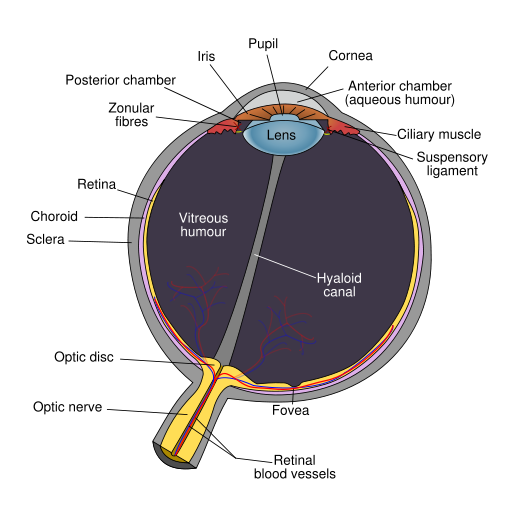Aqueous humour

Overview
The aqueous humour is a thick watery substance that is located in the eye.
Locations
The anterior segment is the front third of the eye that includes the structures in front of the vitreous humour: the cornea, iris, ciliary body, and lens.[1] Within the anterior segment are two fluid-filled spaces divided by the iris plane:
- 1) the anterior chamber between the posterior surface of the cornea (i.e. the corneal endothelium) and the iris.
- 2) the posterior chamber between the iris and the front face of the vitreous.[1]
Aqueous humour fills these spaces within the anterior segment to provide nutrients to the lens and corneal endothelium, and its pressure maintains the convex shape of the cornea.[2][3]
In a healthy eye, the aqueous humour does not mix with the firm, gel-like vitreous humour because of the lens and its Zonule of Zinn between the two.
Functions
- Maintains the intraocular pressure and inflates the globe of the eye.
- Provides nutrition for the avascular ocular tissues; posterior cornea, trabecular meshwork, lens, and anterior vitreous.
- Carries away waste products from metabolism of the above avascular ocular tissues.
- May serve to transport ascorbate in the anterior segment to act as an anti-oxidant agent.
- Presence of immunoglobulins indicate a role in immune response to defend against pathogens.
Its main function is to provide diopteric power to the cornea.
Composition
- Water: 99%[4]
- Ions: HCO3-, buffers metabolic acids; Cl-, preserves electric neutrality; Na+; K+; Ca2+; PO42-.
- Proteins: albumin, β-globulins. Very low density due to filtration.
- Ascorbate: anti-oxidative, protects against UV.
- Glucose
- Lactate: produced by metabolism of anaerobic structures of the eye.
- Amino acids: transported by cilary epithelial cells.
Production and drainage
Aqueous humour is secreted into the posterior chamber by the ciliary body, specifically the ciliary processes. It flows through the narrow cleft between the front of the lens and the back of the iris, to escape through the pupil into the anterior chamber, and then to drain out of the eye via the trabecular meshwork. From here, it drains into Schlemm's canal by one of two ways: directly, via aqueous vein to the episcleral vein, or indirectly, via collector channels to the episcleral vein by intrascleral plexus and eventually into the veins of the orbit.
Production
- Filtration: As blood flows in the cilary body's capillaries, it is coarsely filtered by the capillaries' endothelial cells. The resulting plasma is then refiltered by the pigmented and nonpigmented cilary epithelial cells and poured into the posterior chamber of the eye as aqueous humor.
- Diamond-Bossert model: Active transport occurring in the nonpigmented cilary epithelial cells induces small osmotic pressure gradients in between the cells. A higher concentration of solutes in the proximal part of the intercellular space generates a flow of water. The concentration diminishes from the proximal part to the distal part, releasing the liquid into the posterior chamber.
Drainage
Aqueous humour is continually produced by the ciliary processes - to maintain a constant intraocular pressure, the production of aqueous humour must be balanced by an equal rate of aqueous humour drainage. Small variations in the changes in production or outflow of aqueous humour will have a large influence on the intraocular pressure.
The primary route for aqueous humour flow is first through the posterior chamber, then the narrow space between the posterior iris and the anterior lens (contributes to small resistance), through the pupil to enter the anterior chamber. From there, the aqueous humour exits the eye through the trabecular meshwork into Schlemm's canal, it flows through 25 - 30 collector canals into the episcleral veins. The greatest resistance to aqueous flow is provided by the trabecular meshwork, and this is where most of the aqueous outflow occurs.
The secondary route is the uveoscleral drainage, and is independent of the intraocular pressure, the aqueous flows through here, but to a lesser extent than through the trabecular meshwork.
Diseases and disorders
Glaucoma is a condition characterised by increased intraocular pressure (pressure within the eye) either through increased production or decreased outflow of aqueous humor.[5] Increased resistance to outflow of aqueous humour may occur due to an abnormal trabecular meshwork or to obliteration of the meshwork due to injury or disease of the iris. Uncontrolled glaucoma typically leads to visual field loss and ultimately blindness.
References
- ↑ 1.0 1.1 "Departments. Anterior segment." Cantabrian Institute of Ophthalmology.
- ↑ Miguel Coca-Prados, Ph.D.
- ↑ Uzzle T. "The Eye, the Ear, and the Brain."
- ↑ Pipe & Rapley, "Ocular Anatomy and Histology" 1999
- ↑ http://www.emedicinehealth.com/understanding_glaucoma_medications/article_em.htm